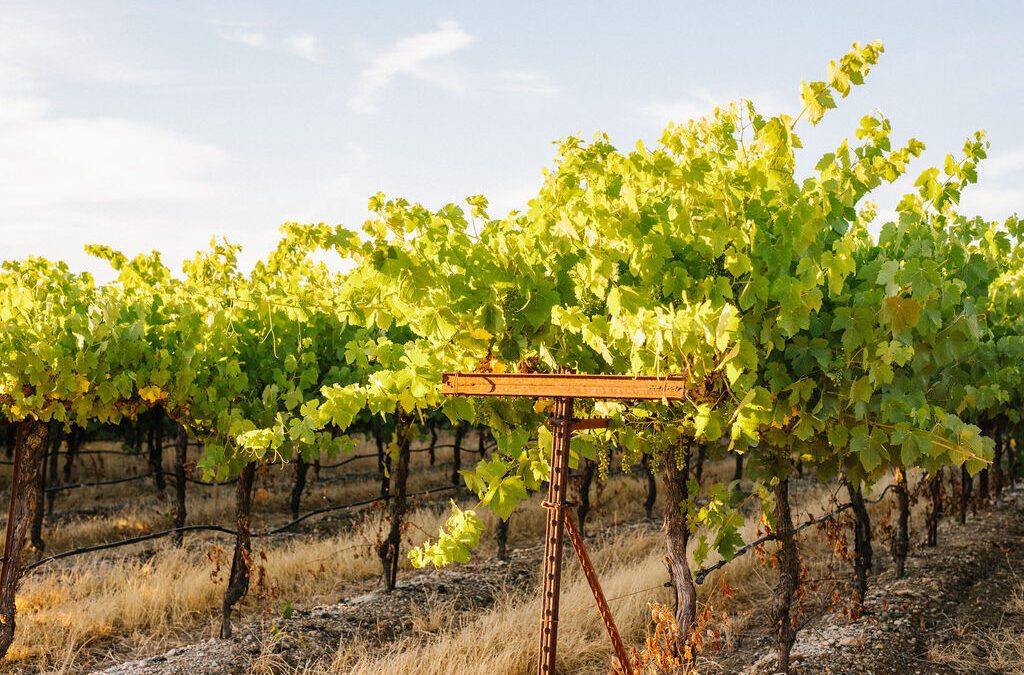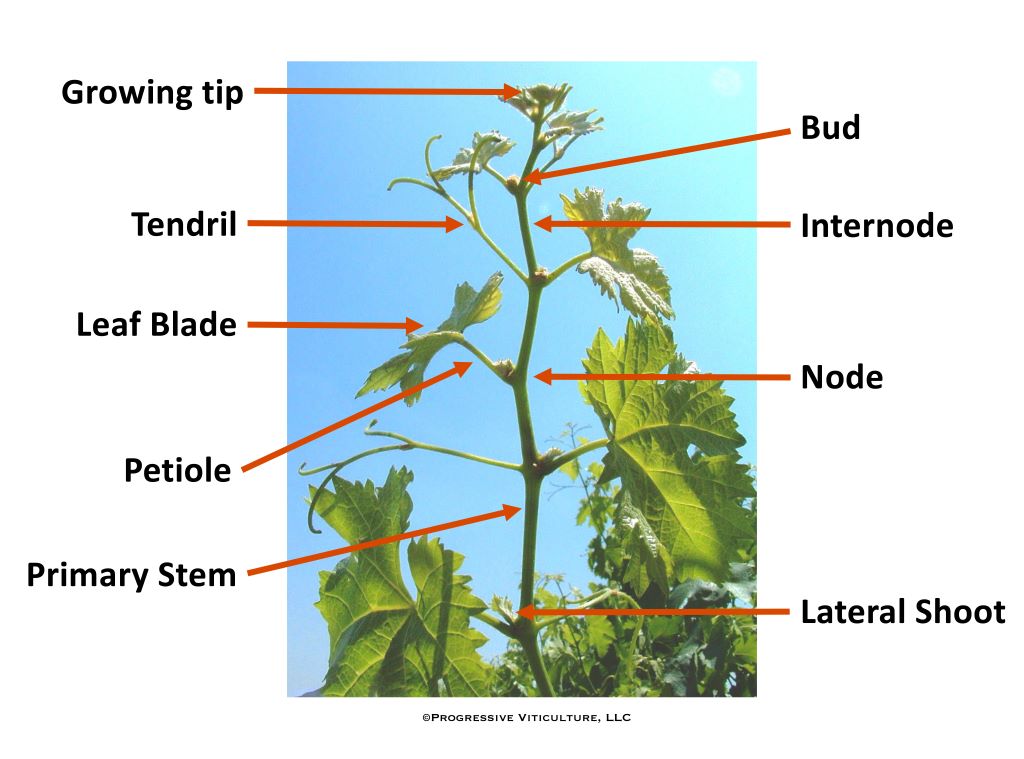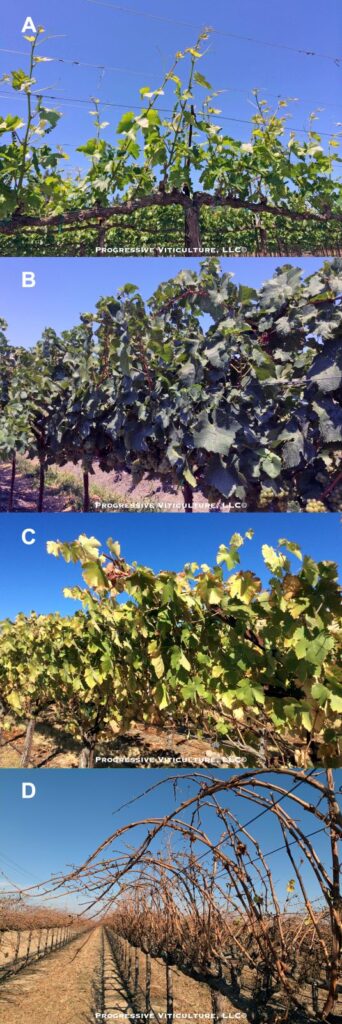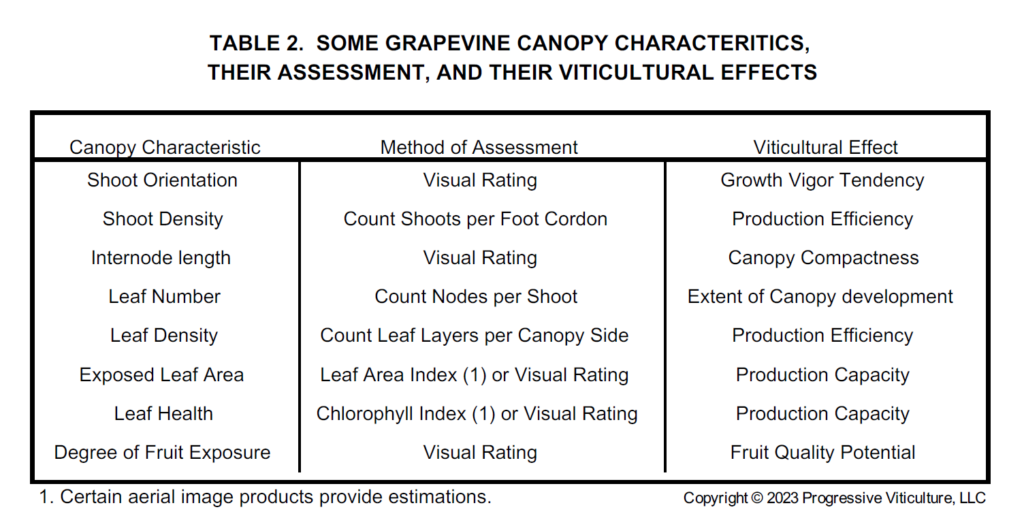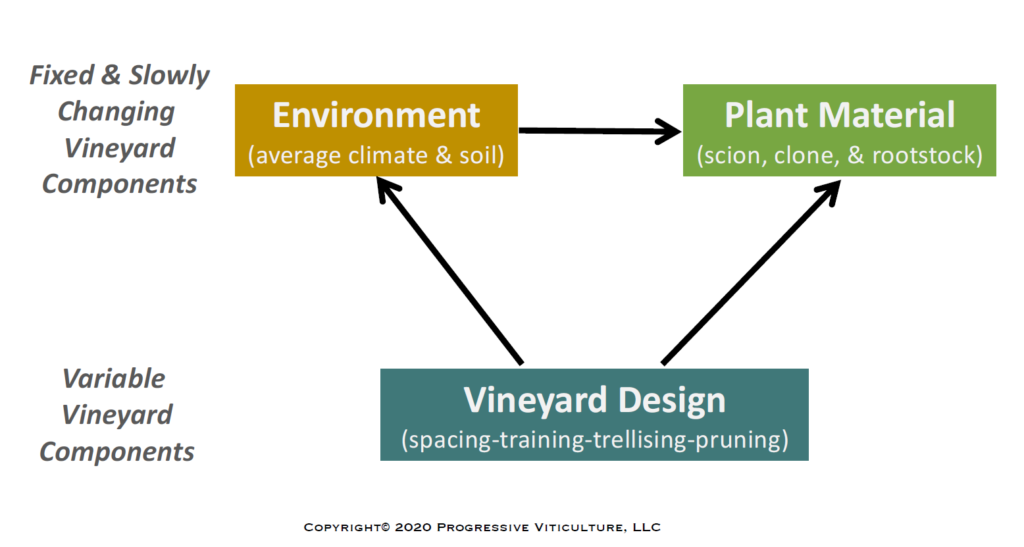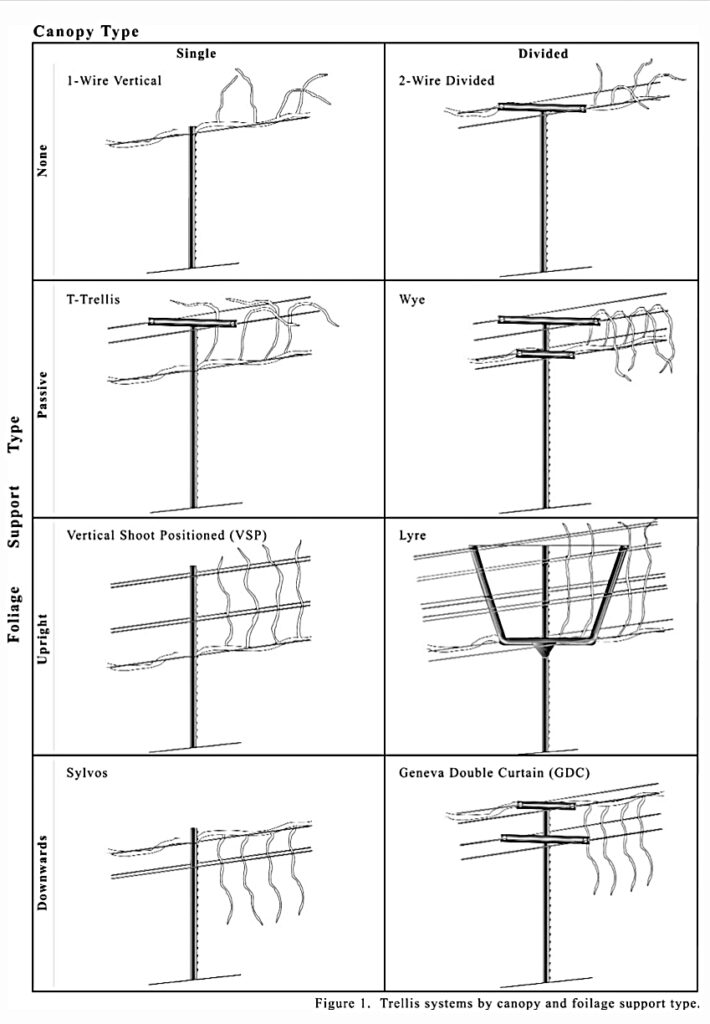MONDAY, DECEMBER 25, 2023. BY STAN GRANT, VITICULTURIST.
There was a time when grape growers gave little thought to grapevine foliage beyond keeping it out of the way of machinery and controlling pests and diseases. Accordingly, hedging the apical ends of shoots and pesticide sprays were the only in-season practices commonly applied to canopies. During the same period, vines were bilateral cordon trained onto simple one, two, or three-wire vertical trellises or trellises with single cross-arms in a T configuration. Such trellises allowed vine foliage to sprawl.
Then, in the 1980s, the canopy management concept emerged. This revolutionary approach to caring for grapevine foliage addressed specific viticultural concerns and its impact has been profound. Canopy management has contributed to marked improvements in winegrape quality at all price points and decreased fungal disease. Just as important, attentive canopy management has improved viticultural efficiency with regard to the crop produced per unit leaf area (crop load) and the crop produced per unit applied resource. Such improvements are possible because vine productivity is contingent on the effective photosynthetic capacity of canopies over the course of a growing season.
In the spirit of continuous improvement, it pays to periodically revisit viticultural practices. Here we do so for canopy management based on a couple of questions. Can our approach to canopy management be more systematic and perhaps, more broadly applicable than in the past? Further, can we set and achieve canopy management goals that make us more consistently successful in our pursuit of efficient production of economically viable yields of high-quality winegrapes over the long term? In this article, we will endeavor to answer these questions as we revisit canopy management. But before we do, we will briefly consider some canopy fundamentals.
About Grapevine Canopies
The definition of a canopy is a cover made of branches. For cultivated grapevines, canopies consist of the current season’s vegetative branches (shoots) upon a foundation of annually replaced woody branches (canes or spurs) connected to permanent woody branches (arms or cordons).
Shoots are the primary canopy subunits of concern. They are multifunctional assemblages of organs. Paramount among these organs are leaves, the grapevine solar panels, in which sunlight-driven photosynthesis produces chemical energy, reducing power, and carbohydrates from water and carbon dioxide to drive vine growth and productivity (Figure 1). Shoots also support tendrils for clinging and climbing towards sunlight, and buds for shoot regeneration, buds and fruit borne on clusters for seed dispersal.
Shoots consist of three zones – basal, mid-shoot, and apical – that lengthen as shoots elongate early in the growing season. When sufficiently elongated, fruit zones reside within the basal sections of shoots.
Shoots undergo four developmental stages: rapid growth, maturation, senescence, and dormancy (Figure 2). Their emergence and initial elongation rely upon nutrient reserves stored in woody vine tissues and root activity, while environmental conditions (atmosphere and soil) influence their rate of growth. After 5 or 6 leaves unfold, shoots have adequate photosynthetic capacity to become self-sufficient to sustain their further growth and development. With further elongation, shoots begin to export carbohydrates to other parts of the vine, including roots.
In young leaves, the rate of photosynthesis rapidly increases before slowly declining about 40 days after they unfolded. Consequently, the zone of maximum photosynthesis moves progressively upwards from the shoot base. At the same time, canopies develop exterior leaves that shade some interior leaves, decreasing their photosynthetic contributions to vine growth and development. Lateral shoots that sometimes emerge from buds in the latter part of the growing season, like young leaves in general, have comparatively high rates of photosynthesis.
Shoot growth and canopy development slows after fruit set and under moderate water stress it stops. These events coincide with a redirection of internal vine resources away from the apical zones of shoots and into developing berries. Varieties, clones, and rootstocks influence shoot growth habits, which can affect canopy attributes (Table 1). Importantly, grapevine canopy attributes influence overall photosynthetic capacity, which in turn impacts vine growth above and below ground; fruit yield, maturation, and quality when ripe; cane ripening and winter hardiness; and the number of stored nutrient reserves in woody tissues at the end of the growing season. Additionally, canopy attributes may affect production efficiency (Table 2).
About Grapevine Canopy Management
Simply stated, canopy management is controlling the number, position, and health of shoots and the leaves and clusters they bear. Canopy management ought to strive to optimize leaf function, maximize production efficiency, enhance fruit and wood quality, minimize disease, and promote a long and productive vineyard life. To achieve these goals, canopy management focuses on three things: achieving growth balance, promoting exposure, and maintaining healthy leaves.
Growth balance refers to two aspects of seasonal vine biomass production. First, the number of exposed, healthy leaves relative to roots, affects soil resource acquisition and allocation in support of canopy and root functions. Second is the number of exposed, healthy leaves relative to fruit, which affects the rate of ripening. Fostering leaf exposure and health, therefore, are basic to achieving growth balance. Additionally, the exposure of clusters to dappled sunlight and moving air is an important concern for berry quality and disease control.
Comprehensive canopy management to achieve the goals stated above involves two complementary approaches. The first, indirect and passive canopy management is the topic of the next section. The sections that follow address facets of direct and active canopy management.
Indirect Canopy Management
Here are a few vineyard realities. Every combination of grapevine variety and rootstock has a certain inherent potential for growth. And every vineyard site imposes limitations on the growth potential of a variety and rootstock. The design of the vineyard directs vine growth, as determined by genetics and environment, and partitions it into organs above and below ground. Simultaneously, the vineyard design will indirectly influence the rate of canopy growth, as well as the final canopy size and spatial dimensions. As such, vineyard design is the basis for indirect canopy management.
The basic objective of vineyard design is to achieve the basic canopy management goals (balanced growth, moderate water stress, and fruit exposure to dappled sunlight) before veraison during an average climate year with minimum inputs after the vines are fully established. Again, in addition to viticultural efficiency, these characteristics contribute to prompt ripening and favorable winegrape quality. Balanced growth is evident in 14 to 20 nodes per shoot, while moderate water stress is apparent as arrested shoot growth, senescent or absent tendrils, and aged, healthy leaves. Dappled fruit exposure occurs when less than 1.0 to 1.5 leaf layers with gaps cover the fruit zone.
The vineyard design process begins with an assessment of environmental factors – climate and soil – which, from a vineyard management perspective, are largely stable (Figure 3, Table 3). Such assessments are often most meaningful when undertaken after the vineyard root zone has been appropriately amended and deep cultivated. Based on the assessment and an approximation of the growth potential of the variety and rootstock, make the best estimate of the mature vine size and growth capacity. This, perhaps the difficult part of vineyard design, requires experience and sometimes, additional expertise drawn from one or more outside sources.
Next, select the variable vineyard design components to accommodate the estimated mature vine size and capacity; using them to direct and partition vine growth in ways that foster the pre-veraison balanced growth, moderate water stress, and favorable fruit zone exposure mentioned above. First, select the length of cordon per vine that favors shoots about 20 nodes long when the shoot density is about 5 to 6 shoots per foot cordon. In the Northern Interior of California, such cordon lengths commonly range between about 8 feet for low-capacity varieties like Pinot Noir to 12 feet of cordon for high-capacity varieties like Cabernet Sauvignon.
Then select a cordon configuration – unilateral, bilateral, or quadrilateral. For unilateral and bilateral cordon-trained vines, the length of the cordon per vine determines the spacing of vines within the vine row. For quadrilateral cordon-trained (horizontally divided) vines, dividing the cordon length per vine by 2 determines the vine spacing.
The space required for equipment when shoots are fully elongated (14 to 20 nodes) and draping into the vine rows determines row spacing. Rows may be narrower for vineyards with trellises providing vertical shoot positioning, which is discussed below, than for those that allow shoots to spread.
The next decision in the vineyard design process involves trellis foliage support. There are four basic types to choose from – no foliage support, passive foliage support, upright & vertical foliage support, and downward foliage support (Figure 4). A few varieties with naturally stiff and mostly upright stems, like Cabernet Sauvignon and Sauvignon Blanc, do not need foliage support unless grown in an area where high winds are common. The passive foliage support provided by T and Wye trellises works well for many high-growth capacity varieties with limber shoots because when sufficiently long, such shoots drape outwards with shoot tips down, and downward tip positioning invigorates shoot growth. Upright and vertical shoot positioning is appropriate where cool temperatures and limited sunshine hours restrict the rate of shoot growth and fruit exposure to sunlight. Downward shoot positioning places the fruit near the tops of canopies, rendering it exposed to direct sunlight – a situation not suited to California’s growing season sunshine and temperatures.
The final vineyard design and indirect canopy management choice involves cordon and canopy height. Leaf area per vine and fruit yield per vine increase with increasing cordon and canopy height. Moreover, higher fruit zones are subject to greater air movement than lower fruit zones. Further, putting canopies higher places them further from soil surfaces, and the radiation reflected from them, can be damaging during hot summer days. Given these factors, it is advantageous to position canopies as high as feasible in most California grape-growing areas.
Failure to use the vineyard design principles presented above can have significant consequences. Where cordons are too long and vine growth capacity is diluted into too many spurs and buds, shoot growth is severely invigorated, canopies fail to fully develop, leaf area is insufficient, vines are overcropped, fruit is overexposed, and berry and cane ripening is impaired. At the other end of the spectrum, where cordons are too short and vine growth capacity is concentrated into too few spurs and buds, shoot growth is unduly invigorated, canopy development is excessive, vines are under-cropped, fruit and interior leaves are shaded, and berry and cane wood quality is substandard. Obviously, indirect canopy management through vineyard design is foundational to sound viticulture.
A version of this article was originally published in the Mid Valley Agricultural Services February 2006 newsletter and was updated for this blog post.
Further Reading
Archer, E and Strauss, HC. The effect of vine spacing on vegetative growth and reproductive performance of Vitis vinifera L. (cv Pinot Noir). S. Afr. J. Enol. Vitic. 1991.
Battany, M. Crop load, viruses, and potassium effects on canopy health. Grape Notes. UC Cooperative Extension, San Luis Obispo, and Sant Barbara counties. December 2005.
Bettiga, LJ (Ed.). Grape pest management. 3rd Ed. University of California Agricultural and Natural Resources, Oakland, CA. Publication 3343. pp.120-125. 2013.
Bledsoe, AM, Kliewer, WM, and Marois, JJ. Effects of timing and severity of leaf removal on yield and fruit composition of Sauvignon blanc. Am. J. Enol. Vitic. 39, 49-54. 1988.
Caccavello, G, Giaccone, M, Scogmamiglio, P, Mataffo, A, Teobaldelli, M, and Basile, B. Vegetative, yield, and berry quality response of Aglianico to shoot trimming applied at three stages of berry ripening. Am. J. Enol. Vitic. 70, 351-359. 2019.
Christensen, LP. Winegrape trellises for the San Joaquin Valley. Unpublished and undated report. Univ. Calif. Coop. Ext.
Christensen, LP. Winegrape canopy management practices in the San Joaquin Valley. American Vineyard Foundation Final Report. 1993.
Dokoozlian, NK, and Kliewer, WM. The light environment within grapevine canopies. I. Description and seasonal changes during fruit development. Am. J. Enol. Vitic. 46, 209-218. 1995a.
Dokoozlian, NK, and Kliewer, WM. The light environment within grapevine canopies. II. Influence of leaf density on fruit zone light environment and some canopy assessment parameters. Am. J. Enol. Vitic. 46, 209-226. 1995b.
Dokoozlian, N. Integrated canopy management: a twenty-year evolution in California. In Dokoozlian, N, and Wolpert, J (ed.). Recent advances in canopy management. Davis, California. July 16, 2009.
English, JT, Thomas, CS, Marois, JJ, and W. D. Gubler, WD. Microclimates of grapevine canopies associated with leaf removal and control of Botrytis bunch rot. Phytopathology. 79, 395-401. 1989.
English, JT, Bledsoe, AM, Marois, JJ, and Kliewer, WM. Influence of grapevine canopy management on evaporative potential in the fruit zone. Am. J. Enol. Vitic. 41, 137-141. 1990.
Freeman, BM, Tassie, E, and Rebbechi, MD. Training and trellising. pp. 42-65. In Coombe, B, and Dry, PR (ed.) Viticulture: Volume 2 Practices. Winetitles, Adelaide. 1992.
Galet, P. General Viticulture. Oenoplurimedia, Chaintre. 2000.
Geller, JP, and Kurtural, SK. Mechanical canopy and crop load management of Pinot gris in a warm climate. Am. J. Enol. Vitic. 64: 65-73. 2013.
Grant, S. Five-step irrigation schedule: promoting fruit quality and vine health. Practical Winery and Vineyard. 21(1): 46-52 and 75. May/June 2000.
Grant, S. Balanced soil fertility management in winegrape vineyards. Practical Winery and Vineyard. May/June 2002. 24 (1): 7-24.
Grant, S. The economics of vineyard design: trellising, vine spacing, and row spacing. January/February 2000. Practical Winery and Vineyard. 20(5): 48-63.
Grant, S. Vineyard management self-evaluation. Lodi Winegrape Commission Coffee Shop. (www.lodigrowers.com). November 18, 2013.
Grant, S. Regulated deficit irrigation, parts I and II. Lodi Winegrape Commission Coffee Shop. (www.lodigrowers.com) (www.lodigrowers.com). July 18 and August 4, 2014.
Grant, S. NRCS soil survey information important to vineyards. Lodi Winegrape Commission Coffee Shop. (www.lodigrowers.com). January 20, 2016.
Grant, S. Evaluating vineyard soils in trenches. Lodi Winegrape Commission Coffee Shop. (www.lodigrowers.com). February 17, 2016.
Grant, S. Comparative wine growing climatology. Lodi Winegrape Commission Coffee Shop. (www.lodigrowers.com). September 29, 2016.
Grant, S. Shoot thinning for multiple benefits. Lodi Winegrape Commission Coffee Shop. (www.lodigrowers.com). May 2, 2017.
Grant, S. To hedge or not to hedge? Lodi Winegrape Commission Coffee Shop. (www.lodigrowers.com). June 6, 2017.
Grant, S. Vineyard longevity. Lodi Winegrape Commission Coffee Shop. (www.lodigrowers.com). November 9, 2017.
Grant, S. Vineyard design and management for maximum efficiency. Lodi Winegrape Commission Coffee Shop. (www.lodigrowers.com). February 22, 2018.
Grant, S. Grapevine shoots and roots: the interconnectedness of the above and below ground grapevine. Wine Business Monthly. February 2019. pp. 148-152.
Grant, S. Vertical shoot positioned trellis systems in warm climates. Lodi Winegrape Commission Coffee Shop. (www.lodigrowers.com). May 06, 2019.
Grant, S. Vine growth capacity and horizontally divided vines. Lodi Winegrape Commission Coffee Shop. (www.lodigrowers.com). June 03, 2019.
Grant, S. Using competition to best advantage in vineyard management. Lodi Winegrape Commission Coffee Shop. (www.lodigrowers.com). June 8, 2020.
Grant, S. The seasonality of vineyard mineral nutrient management. Lodi Winegrape Commission Coffee Shop. (www.lodigrowers.com). May 24, 2021.
Grant, S. Mineral nutrient management methods. Wine Business Monthly. May 2022. pp. 44-49.
Gubler, W. D., J. J. Marois, A. M. Bledsoe, and L. J. Bettiga. Control of Botrytis bunch rot of grape with canopy management. Plant Dis. 71, 599-601.1987.
Gutierrez-Gamboa, G, Marin-san Roman, S, Jofre, V, Rubio-Breton, P, Perez-Alvarez, EP, and Garde-Cerdan, T. Effects on chlorophyll and carotenoid contents of different grape varieties (Vitis vinifera L.) after nitrogen and elicitor foliar applications to the vineyard. Food Chemistry. 269, 380-386. 2018.
Hedberg, PR, and Raison, J. The effect of vine spacing and trellising on yield and fruit quality of Shiraz grapevines. Am. J. Enol. Vitic. 33: 20-30. 1982.
Howell, GS. Sustainable grape productivity and the growth-yield relationship: a review. Am. J. Enol. Vitic. 53, 165-174. 2001.
Hunter, JJ, and Ruffner, HP. Diurnal and seasonal changes in nitrate reductase activity and nitrogen content of grapevines: effect of canopy management. Vitis. 36, 1-6. 1997.
Intrieri, C. Experiences on the effect of vine spacing and trellis-training system on canopy micro-climate, vine performance, and grape quality. Acta Hortic. 206: 69-87. 1987.
Intrieri, C, Poni, S, Rebucci, B, and Magnini, E. Effects of canopy management on whole-vine photosynthesis; results from pot and field experiments. Vitis. 36, 167-173. 1997.
Intrieri, C, and Filippetti, I. Planting density and physiological balance: comparing approaches to European viticulture in the 21st century. pp. 296-308. In Proceedings of the ASEV 50th anniversary annual meeting. Seattle. June 19-23, 2000.
Jackson, D. Pruning and training. (Monographs in cool climate viticulture-1). Lincoln University Press, Canterbury, NZ. 1997.
Jackson, DI, and Lombard, PB. Environmental and management practices affecting grape composition and wine quality – A review. Am. J. Enol. Vitic. 44, 409-430. 1993.
Jensen, F, Andris, H, Beebe, B, and Bettiga, L. The effects of row spacing, variety, and trellis on yields of three wine varieties. Unpublished report. Univ. Calif. Coop. Ext.
Keller, M. Deficit irrigation and mineral nutrition. Proceedings of the Soil Environment and Mineral Nutrition Symposium. Christensen, LP, Smart, DR (ed.). Amer. Soc. Enol. Vitic. pp. 267-283. 2005.
Keller, M. The science of grapevines. Academic Press, Burlington, MA. 2010.
Kliewer, W. M. and R. E. Smart. Canopy manipulation for optimizing vine microclimate, crop yield, and composition of grapes. In: Manipulations of Fruiting. C. J. Wright (Ed). pp. 275-290. Butterworths, London. 1989.
Kliewer, WM, and Casteel, T. Canopy management. In Hellman, EW (ed). Oregon viticulture. Oregon State University Press, Corvallis. pp.177-184. 2003.
Matthews, MA. Terroir and other myths. University of California Press. Oakland. 2015.
Mullins, MG, Bouquet, A., and Williams, LE. Biology of the grapevine. Cambridge University Press, Cambridge. 1992.
Myers, JK, Wolpert, JA, and Howell, GS. Effect of shoot number on the leaf area and crop weight relationship of young Sangiovese grapevines. Am. J. Enol. Vitic. 59, 422-424. 2008.
Reynolds, AG, and Wardle, DA. Impacts of various canopy manipulation techniques on growth, yield, fruit composition, and wine quality of Gewurztraminer. Am. J. Enol. Vitic. 40, 121-129. 1989.
Reynolds, AG, Wardle, DA, and Dever, M. Shoot density effects on Riesling grapevines: interactions with cordon age. Am. J. Enol. Vitic. 457, 435-443. 1994.
Reynolds, AG, Wardle, DA, and Naylor, AP. Impact of training system, vine spacing, and basal leaf removal on Riesling. Vine performance, berry composition, canopy microclimate, and vineyard labor requirements. Am. J. Enol. Vitic. 47: 63-76. 1996.
Reynolds, AG. Impact of trellis/training systems and cultural practices on production efficiency, fruit composition, and vine balance. In: JM Rantz (ed). Proc. ASEV 50th Anniversary Meeting. Seattle, WA. pp. 309-317. 2000.
Schubert, A, Restagno, M, Novello, V, and Peterlunger, E. Effects of shoot orientation on growth, net photosynthesis, and hydraulic conductivity of Vitis vinifera L. cv. Cortese. Am J. Enol. Vitic. 46, 324-328. 1995.
Shaulis, N, Amberg, H, and Crowe, D. Response of Concord grapes to light exposure and Geneva double curtain training. Proc. Amer. Soc. Hort. Sci. 89: 268-80. 1966.
Shaulis, NJ. Responses of grapevines and grapes to spacing of and within canopies. In A. Webb (ed).Grapes and Wine Centennial Symposium Proceedings. Davis, Calif. Univ. Calif. 80. 1982.
Shultz, HR. Photosynthesis of sun and shade leaves of field-grown grapevines (Vitis vinifera L.) in relation to leaf age. Suitability of the plastochron concept for the expression of physiological age. Vitis. 32, 197-205. 1993.
Shultz, HR. Grape canopy structure, light microclimate, and photosynthesis. I. A two-dimensional model of the spatial distribution of surface area densities and leaf ages in two canopies. Vitis. 34, 211-215. 1995.
Smart, RE. Principles of grapevine canopy management microclimate manipulation with implications for yield and quality. A review. Am. J. Enol. Vitic. 36, 230-239. 1985.
Smart, RE. Shoot spacing and canopy light microclimate. Am. J. Enol. Vitic. 39, 325-333. 1988.
Smart, RE. Canopy management. In: Coombe, B; Dry, PR (ed). Viticulture: Volume 2 Practices. Winetitles, Adelaide. pp 85-103. 1992.
Smart, R, and Robinson, M. Sunlight into wine: A Handbook for Winegrape Canopy Management. Winetitles, Adelaide. 1991.
Stapleton, J. J. and R. S. Grant. Leaf removal for nonchemical control of summer bunch rot complex of winegrapes in the San Joaquin Valley. Plant Dis. 76, 205-208. 1992.
Steel, M, Gitelson, AA, and Rundquist, D. Nondestructive estimation of leaf chlorophyll content in grapes. Am. J. Enol. Vitic. 59, 299- 305. 2008.
Terry, DB, and Kurtural, SK. Achieving vine balance of Syrah with mechanical canopy management and regulated deficit irrigation. Am. J. Enol. Vitic. 62: 426-437. 2011.
Tommaso, F, Acimovic, D, VanderWeide, J, Tombesi, S, Palliotti, A, Gatti, M, Poni, S, and Sabbatini, P. Whole-canopy source-sink balance at bloom dictates fruit set in cv. Pinot noir subjected to early leaf removal. Am. J. Enol. Vitic. 70, 411-419. 2019.
Verdenal, T, Zufferey, V, Huberty, M, Melot, C, Dienes-Nagy, A, and Spring, J-L. Leaf area management affects grape nitrogen content. IVES Technical Reviews. October 2021. https://ives-technicalreviews.eu/article/view/4852.
Velez, S, Poblete-Echeverria, C, Rubio, JA, Vacas, R, and Barajas, E. Estimation of leaf area index in vineyards by analyzing projected shadows using UAV imagery. OENO One. 159-180. 2021.
Weaver, RJ, and Kasimatis, AN. Effect of trellis height on with and without cross-arms on yield of Thompson Seedless grapes. Journal of the American Society for Horticultural Science. 100, 252-253. 1975.
Weaver, RJ, Kasimatis, AN, Johnson, JO, and Vilas, N. Effect of trellis height and cross-arm width and angle on yield of Thompson Seedless grapes. American Journal of Enology and Viticulture. 35, 94-96. 1984.
Wang, X, De Bei, R, Fuentes, S, and Collins, C. Influence of canopy management practices on canopy architecture and reproductive performance of Semillon and Shiraz grapevines in a hot climate. Am. J. Enol. Vitic. 70, 306-372. 2019.
Westwood, MN. Temperate-zone pomology: physiology and culture. Timber Press. Portland. pp 523. 1993.
Winkler, AJ, Cook, JA, Kliewer, WM, and Lider, LA. General Viticulture. University of California, Berkeley. 1974.
Zufferey, V, Mursier, F, and Shultz, HR. A model analysis of the photosynthetic response of Vitis vinifera L. cvs Riesling and Chasselas leaves in the field. I. Interaction of age, light, and temperature. Vitis. 39, 19-26. 2000.
Have something interesting to say? Consider writing a guest blog article!
To subscribe to the Coffee Shop Blog, send an email to stephanie@lodiwine.com with the subject “blog subscribe.”
To join the Lodi Growers email list, send an email to stephanie@lodiwine.com with the subject “grower email subscribe.”
To receive Lodi Grower news and event promotions by mail, send your contact information to stephanie@lodiwine.com or call 209.367.4727.
For more information on the wines of Lodi, visit the Lodi Winegrape Commission’s consumer website, lodiwine.com.
For more information on the LODI RULES Sustainable Winegrowing Program, visit lodigrowers.com/standards or lodirules.org.

